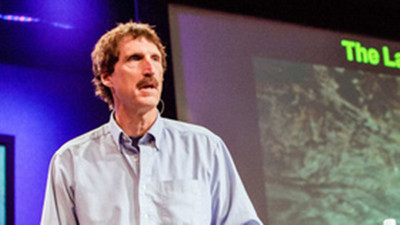We either draw in a liquid sample,
我們收集液體樣本,
or we can actually take a solid core from the wall.
或者我們從墻體上直接采集固體巖芯標本。
No hands at the wheel.
這一過程無需人來遙控。
This is all behavioral autonomy here that's being conducted by the robot on its own.
這全都由機器人自己執行。
The real hat trick for this vehicle, though, is a disruptive new navigation system we've developed,
這臺機器最大的創新是一種我們研發的與眾不同的導航系統,
known as 3D SLAM, for simultaneous localization and mapping.
被稱作3D SLAM,用于同時定位和畫圖。
DEPTHX is an all-seeing eyeball.
深水熱源探測儀是一種全視角眼球。
Its sensor beams look both forward and backward at the same time,
它的感應光源可以同時向前向后,
allowing it to do new exploration while it's still achieving geometric sensor-lock on what it's gone through already.
允許它做新的探索同時它能將感應到的它所經過的地方地幾何圖形鎖定。
What I'm going to show you next is the first fully autonomous robotic exploration underground that's ever been done.
我接下來要給你展示的是有史以來第一個全自動地下探索機器人。

This May, we're going to go from minus 1,000 meters in Zacaton,
今年五月,我們準備從扎卡頓地下一千米處出發,
and if we're very lucky, DEPTHX will bring back the first robotically-discovered division of bacteria.
如果我們幸運,深水熱源探測儀將會帶回第一個機器人獨立發現的細菌切片。
The next step after that is to test it in Antartica and then, if the funding continues and NASA has the resolution to go,we could potentially launch by 2016, and by 2019 we may have the first evidence of life off this planet.
那之后的第二步是在南極洲對它做測試,然后如果資金許可,并且美國宇航局有決心,我們可能在2016年前開始實施(探索外星)計劃,在2019年我們有可能得到證明地球外的生命存在第一個證據。











